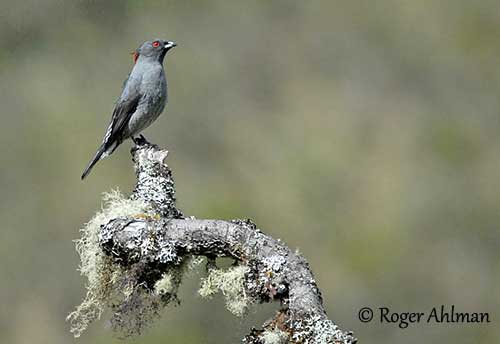
Fr: Cotinga à huppe rouge
Ang: Red-crested Cotinga
All: Rotschopfkotinga
Esp: Cotinga crestirrojo
Ita: Cotinga crestarossa
Nd: Roodkuifcotinga
Sd: rödtofskotinga
Photographers:
Roger Ahlman
Pbase Galleries Peru and Ecuador & My bird pictures on IBC
Dubi Shapiro
Dubi Shapiro Photo Galleries & Dubi Shapiro's Pictures on IBC
Text by Nicole Bouglouan
Sources:
HANDBOOK OF THE BIRDS OF THE WORLD Vol 9 - by Josep del Hoyo - Andrew Elliot - David Christie - Lynx Edicions - ISBN: 8487334695
BIRDS OF PERU by Thomas S. Schulenberg, Douglas F. Stotz, Daniel F. Lane, John P. O’Neill, Theodore A. Parker III – Princeton University Press 2007– ISBN: 978-0-691-13023-1
BIRDS OF SOUTH AMERICA – Passerines - by Robert S. Ridgely and Guy Tudor – HELM Field Guides – ISBN: 9781408113424
A GUIDE TO THE BIRDS OF COLOMBIA by Steven L. Hilty and William L. Brown - Princeton University Press – ISBN 069108372X
Birds of Ecuador De Robin Restall, Juan Freile – Editeur: Bloomsbury Publishing, 2018 – ISBN: 1472925653, 9781472925657 – 576 pages
Birds of Western Ecuador: A Photographic Guide Par Nick Athanas, Paul J. Greenfield – Editeur: Princeton University Press, 2016 – ISBN: 140088070X, 9781400880706
Avibase (Denis Lepage)
Birdlife International
Neotropical Birds – Cornell Lab of Ornithology
Wikipedia, la enciclopedia libre
CREAGUS@Monterey Bay (Don Roberson)
Home page
Page Passeriformes Order
Red-crested Cotinga
Ampelion rubrocristatus
Passeriformes Order – Cotingidae Family
INTRODUCTION:
The Red-crested Cotinga is widespread and described as locally fairly common. It occurs at high elevations in the Andes, from W Venezuela and N Colombia, through Ecuador and Peru to Bolivia. It can be seen at borders of upper montane forest and woodland, up to the treeline, but it also frequents agricultural areas bordered with trees. It feeds mainly on fruits and berries, and also takes insects in the air.
The Red-crested Cotinga shows a beautiful red crest often lying flat along the nape, but this ornament is raised and transversely spread when the bird is excited. This conspicuous crest contrasts strongly with the dark grey plumage.
The Red-crested Cotinga was first described in 1837 by French naturalists Alcide d’Orbigny and Frederic de Lafresnaye.
The species is not globally threatened and currently occurs in several areas and national parks throughout its wide range.

DESCRIPTION OF THE BIRD:
Biometrics:
Length: 21 cm
Weight: M: 51-80 g – F: 47-67 g
The Red-crested Cotinga has grey plumage overall, but the head is darker, like wings and tail. There is a white streaking on both upper and undertail-coverts, extending sometimes across rump and vent. The dark tail shows a white subterminal bar, mainly visible on the undertail or when the bird is flying.
On the head, the long red crest is usually flat along the nape, but it becomes very conspicuous when flared.
The bill is chalky white or pale greyish with blackish tip. The eyes are deep red. Legs and feet are dark grey to blackish.
Male and female have similar plumage.
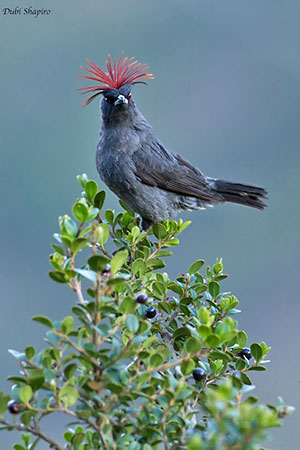
The juvenile lacks the crest. It has browner plumage with whitish streaks on rump. The underparts are whitish with dark streaking. The belly is mostly pale yellow.
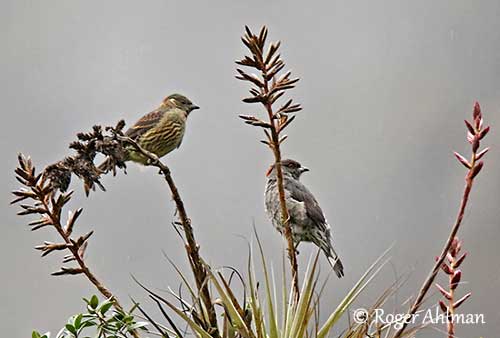
RANGE:
The Red-crested Cotinga occurs in the Andes from W Venezuela to W Bolivia, through Colombia, Ecuador and Peru.
HABITAT:
The Red-crested Cotinga occurs at borders of cloud forest and woodland up to the treeline, and also in semi-open areas with scattered trees and bushes. It can be seen locally in agricultural fields bordered with hedgerows and patches of trees.
This species is visible from 2,200 metres to 3,900/4,000 metres of elevation, but rarely below 2,200 metres.

CALLS AND SONGS: SOUNDS BY XENO-CANTO
The Red-crested Cotinga gives a deep, toneless ticking interspersed with grunts and rattles “tik-tik-tik-t’turr”. We can also hear a low, guttural “rrreh” which is the most usual call.
During the displays, the pair produces various deep, harsh, nasal sounds including a weird nasal reeling or buzzing note “wah-wah-wah…” during the raising-crest display.
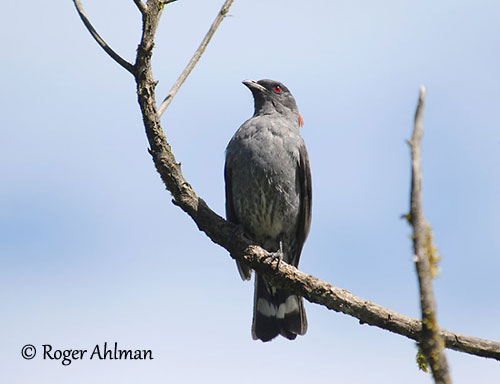
BEHAVIOUR IN THE WILD:
The Red-crested Cotinga feeds primarily on berries and fruits, but it also takes insects.
Fruit and berries include Hedyosmum, Hesperomeles, Oreopanax and Miconia plant species. It plucks them during aerial sallies but also while perched. Insects are caught by short sallies from exposed perches.
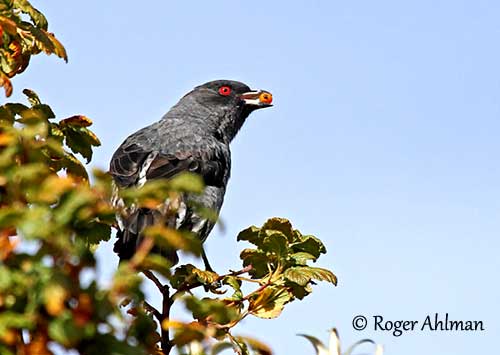
It is usually seen alone or in pairs, perched motionless in upright stance at top of bush or tree. It is rarely observed in mixed-species flocks.
During the displays between two birds, they raise and fan the red crest while bowing with spread tail in front of each other. The crest-lifting display is accompanied by nasal calls.
The Red-crested Cotinga is resident, with probably some movements related to food resources.
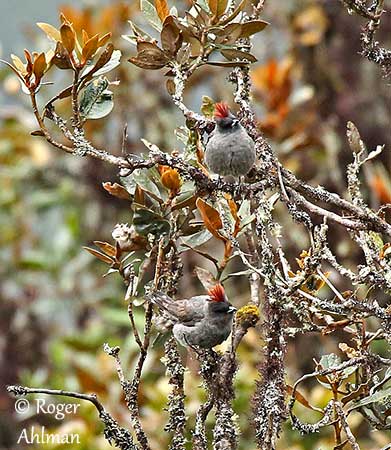
REPRODUCTION OF THIS SPECIES:
The breeding season occurs between February and August in Colombia and mainly in October in Ecuador, whereas laying is recorded in January in Peru and in November in Bolivia. These variations may suggest that the breeding period is not clearly defined throughout the range.
The large cup-shaped nest is made with mosses, lichens and twigs. It is usually built in bush or on low branch in tree, between 1,3 and 3 metres above the ground.
The female lays one or two eggs. Information on incubation and fledging period is currently not available.
PROTECTION / THREATS / STATUS:
The Red-crested Cotinga is described as locally fairly common throughout its wide range. This species tends to tolerate some disturbed habitats, and in addition, it occurs in several protected areas and national parks throughout the range.
The population is suspected to be stable.
The Red-crested Cotinga is not globally threatened and currently evaluated as Least Concern.
